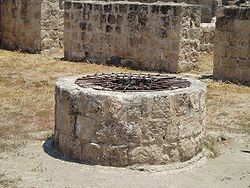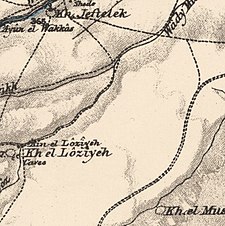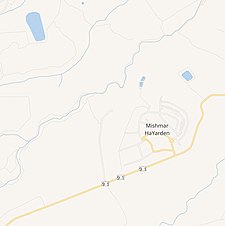Yarda, Safad
Yarda
ياردا | |
|---|---|
Village | |
 Well at Yarda | |
| Etymology: Kh. Wakkâs, the ruin of the man with a broken neck[1] Kh. Lôzîyeh, the ruin of the almond tree[2] | |
A series of historical maps of the area around Yarda, Safad (click the buttons) | |
Location within Mandatory Palestine | |
| Coordinates: 33°0′27″N 35°35′38″E / 33.00750°N 35.59389°E | |
| Palestine grid | 205/268 |
| Geopolitical entity | Mandatory Palestine |
| Subdistrict | Safad |
| Population (1945) | |
| • Total | 20[3][4] |
| Current Localities | Ayyelet ha-Shahar[5] and Mishmar ha-Yarden[5] |
Yarda was a Palestinian hamlet in the Safad Subdistrict. It was depopulated during the 1947–1949 Palestine war. It was located 10.5 km northeast of Safad. The area is now part of Israel.
History[edit]
Khirbat Waqqas was located west-northwest of Yarda, and is recognised as the place the Canaanites referred to as Hazor. Victor Guérin found at Kh. Waqqas in 1875: 'Near a small enclosure, in the centre of which is a broken column consecrated to a santon, are shown the remains of an edifice oriented east and west, once probably a church. It was ornamented with monolithic columns in ordinary limestone, some broken pieces of which are still lying about. Other similar fragments are found in the neighbouring houses. Here and there I remarked cut stones, which no doubt belonged to this monument. A little to the south, a hillock is also covered with ruins of houses.'[6] In 1881, the PEF's Survey of Western Palestine (SWP) found at Kh. Wakkas only cattle-sheds.[7]
Yarda itself was located at a place called Kh el Loziyeh in the late Ottoman era. In 1881, the SWP found here: "Caves and ruined cattle sheds".[8]
British Mandate era[edit]
In the 1931 census of Palestine, conducted by the British Mandate authorities, Yarda had a population of 13 Muslims, in a total of 3 houses.[9]
In the 1945 statistics, the population was 20 Muslims,[3] who owned 1,367 dunams of land.[4] Of this, 1,359 dunams were used for cereals,[10] while 8 dunams were classified as un-cultivable area.[11]
Post 1948[edit]
After Yarda became depopulated, Ayyelet ha-Shahar took over some of the village land, while in 1949 Mishmar ha-Yarden was also settled on village land.[5]
In 1992 the village site was described: "The truncated walls of some houses still stand, as well as those of a khan, or caravansary. The site is strewn with stones from crumbled houses. A portion of the land is used as pasture."[12]
References[edit]
- ^ Palmer, 1881, p. 86
- ^ Palmer, 1881, p. 84
- ^ a b Department of Statistics, 1945, pp. 09, 11
- ^ a b Government of Palestine, Department of Statistics. Village Statistics, April, 1945. Quoted in Hadawi, 1970, p. 69
- ^ a b c Khalidi, 1992, p. 504
- ^ Guérin, 1880, p. 452; as translated in Conder and Kitchener, 1881, SWP I, p. 248
- ^ Conder and Kitchener, 1881, SWP I, p. 248
- ^ Conder and Kitchener, 1881, SWP I, p. 242
- ^ Mills, 1932, p. 111
- ^ Government of Palestine, Department of Statistics. Village Statistics, April, 1945. Quoted in Hadawi, 1970, p. 118
- ^ Government of Palestine, Department of Statistics. Village Statistics, April, 1945. Quoted in Hadawi, 1970, p. 168
- ^ Khalidi, 1992, pp. 504-505
Bibliography[edit]
- Conder, C.R.; Kitchener, H.H. (1881). The Survey of Western Palestine: Memoirs of the Topography, Orography, Hydrography, and Archaeology. Vol. 1. London: Committee of the Palestine Exploration Fund.
- Department of Statistics (1945). Village Statistics, April, 1945. Government of Palestine.
- Grootkerk, Salomon E. (2000). Ancient sites in Galilee: a toponymic gazetteer (Illustrated ed.). BRILL. ISBN 978-90-04-11535-4. (p. 122)
- Guérin, V. (1880). Description Géographique Historique et Archéologique de la Palestine (in French). Vol. 3: Galilee, pt. 2. Paris: L'Imprimerie Nationale.
- Hadawi, S. (1970). Village Statistics of 1945: A Classification of Land and Area ownership in Palestine. Palestine Liberation Organization Research Center.
- Khalidi, W. (1992). All That Remains:The Palestinian Villages Occupied and Depopulated by Israel in 1948. Washington D.C.: Institute for Palestine Studies. ISBN 0-88728-224-5.
- Mills, E., ed. (1932). Census of Palestine 1931. Population of Villages, Towns and Administrative Areas. Jerusalem: Government of Palestine.
- Palmer, E.H. (1881). The Survey of Western Palestine: Arabic and English Name Lists Collected During the Survey by Lieutenants Conder and Kitchener, R. E. Transliterated and Explained by E.H. Palmer. Committee of the Palestine Exploration Fund.
External links[edit]
- Welcome to Yarda
- Yarda, Zochrot
- Yarda, Villages of Palestine
- Survey of Western Palestine, map 4: IAA, Wikimedia commons
- Yarda, at Khalil Sakakini Cultural Center






